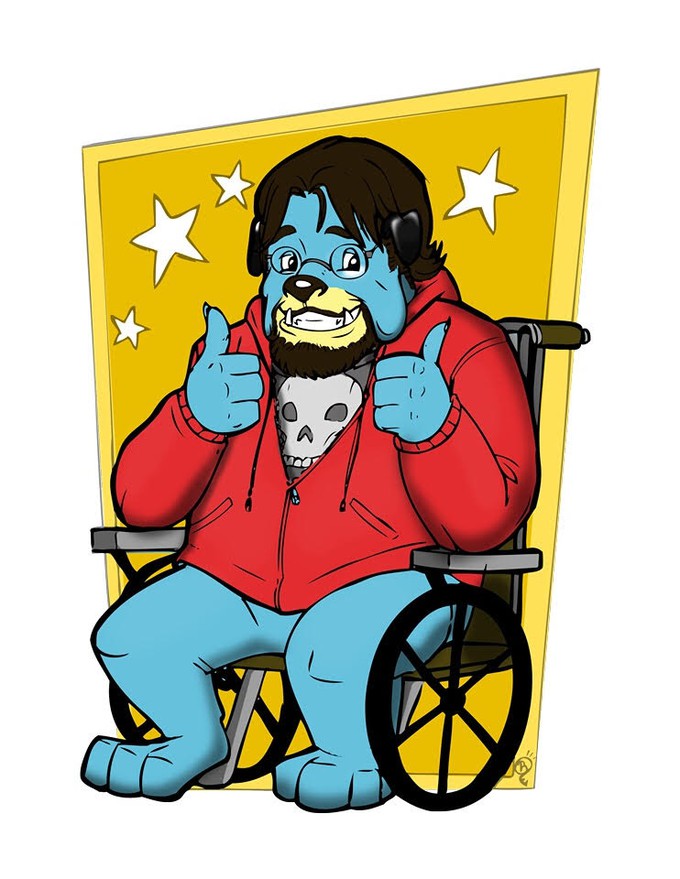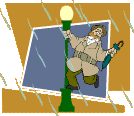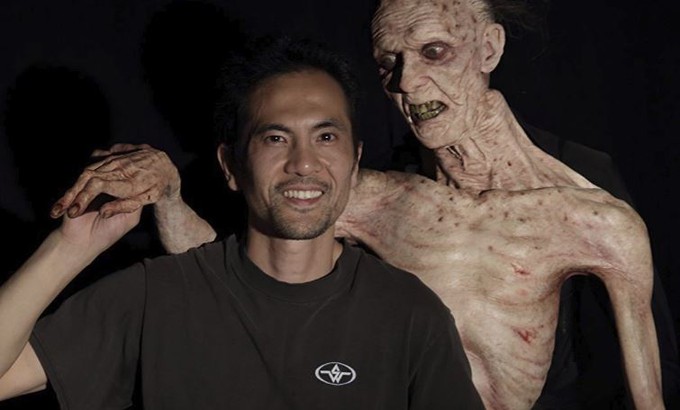
Hiroshi Katagiri is a makeup effects master. He has worked on such high profiles films as LOOPER, PACIFIC RIM, THE HUNGER GAMES, and CABIN IN THE WOODS just to name a few. He has worked with some of the most creative filmmakers in the world and now is preparing to release his very first feature-length directorial effort, GEHENNA: WHERE DEATH LIVES on May 4th.
GEHENNA: WHERE DEATH LIVES is a claustrophobic horror film, with great practical effects work, about a group of people who get trapped in a WWII-era abandoned bunker with a supernatural force.
Hiroshi Katagiri talked with me recently about his career, how he got his start in effects work, the challenges of directing, and just a little bit of information about a certain female-led Marvel movie he worked on that’s slated to be released early next year. His story is one of dedication and hard work paying off in a great example of the American dream coming true.
Please enjoy my interview with effects master Hiroshi Katagiri.
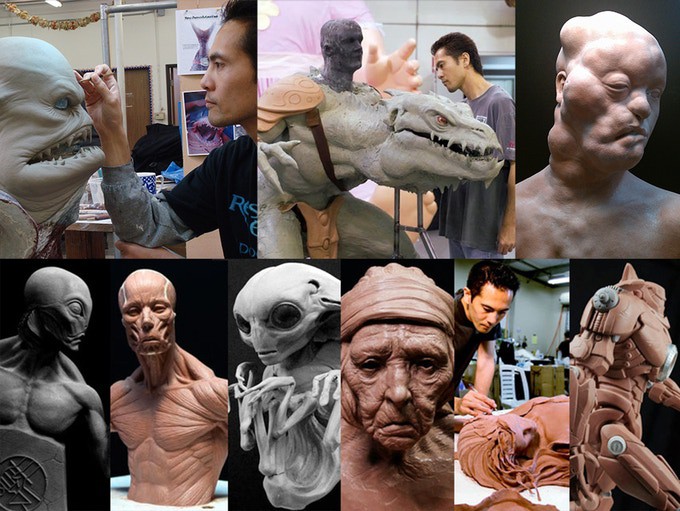
Wheels: How did you get your start in the special effects industry?
Hiroshi Katagiri: It was a long time ago after finishing high school, in Japan, I move to America to pursue this career. Since I didn’t know any single person on this continent [laughs], …yeah I didn’t know anybody. The first place I went… I found a school. There is a school in Los Angeles. It was only ten weeks. [It was] a makeup effects school. You know, the basic skills of makeup? …Of course, I tried hard. [After that] there was a day course and a night course and I was there every day practicing. I was there every day and every night practicing. I built up my portfolio.
The funny thing is, since I was working so hard, the school got me a job. Many productions were asking for cheap labor or free labor.
W: Like being an intern or an understudy?
HK: Yes. I was a really good student so they recommended me for those [jobs]. One day, while I was doing cheap stuff like scar [makeup] for customers at a Halloween store. It was kind of a cheap job but I did it anyway. Funny thing is the cashier at that store knew a producer of a sci-fi film called THE GUYVER.
W: With Mark Hamill.
HK: Yes. Yes! [laughs] So, my friend gave me the phone number of [the producer]. This was 1991? So there was no internet, I just had to call. I was nineteen years old and so scared. [laughs] So many nervous feelings… but at one point I just made [the] phone call. I introduced myself. I explained that this is what I do and this what I want to be doing [professionally] and if you have time please meet with me and listen to my story. He was really nice. He invited me and [set up] an appointment. I met him and showed him my portfolio. He liked my attitude, I think. [laughs] Then he introduced me to the guy who did the effects for THE GUYVER. His name was ‘Screaming Mad George’ [aka Joji Tani, created makeup and creature effects for PREDATOR, BIG TROUBLE IN LITTLE CHINA, A NIGHTMARE ON ELM STREET 3: THE DREAM WARRIORS, and many other films].
After the meeting, he called up George and set up an appointment for me. That was really nice [of him]. A few days later I met George and showed him my portfolio. I told him I’ll do anything… please let me work here. I don’t even need money. [laughs] He accepted. In the beginning, I had nothing good …because my skills were not so good. I was just a beginner. [I had no] working visa in America and also my English skills were not as good …But the one thing I could do better than anybody else, I could work harder or longer than anybody else. That is what I did. The work was, like, 9 [am] to 7 [pm]. I was just staying late every day. If George needed anything else, I volunteered to do that. I was there all the time except for sleeping. I had nothing at home, no TV, no videos. I had nothing to do if I go home. So, I just stayed in the studio.
If there was nothing to do, I’d be practicing my own stuff, like making masks, props. I was George’s intern, so I wasn’t getting paid, but I could use the materials and I was taking full advantage of that! [laughs] Then if he needed anything else, I was happy to help out. At the end of the project.. in the beginning he told me he can’t pay [me] but at the end of the project, he paid me because I was working so hard and he felt guilty. …Soon after I won the green card lottery.
W: Oh wonderful!
HK: Yes! I was super lucky. First [time I applied], I won. The next year when I was twenty I could work legally, and my first legal job was GUYVER 2! [laughs]
W: When creating special effects make up, for example creating monsters, how do you take your ideas and translate them into three dimensions? What is your process?
HK: It starts with the story. In [GEHENNA: WHERE DEATH LIVES for example], each person has their own nightmare, what they fear… So, I think about what would be scary to show… The scary parts I changed often in the script writing process, trying to think ‘what would make it scarier’? It all came from what would be scary if you saw it in this kind of situation. Then I just design the creature characters.
W: Do you start with drawings?
HK: Usually, I just directly sculpt… It’s much quicker.
W: It’s quicker to sculpt?
HK: For me! [laughs] Not for everybody else. [laughs]
W: You’ve worked on many big projects. What was your personal favorite one?
HK: I’d say CABIN IN THE WOODS and PIRATES OF THE CARRIBEAN: ON STRANGER TIDES.
W: Tell me about working on CABIN IN THE WOODS.
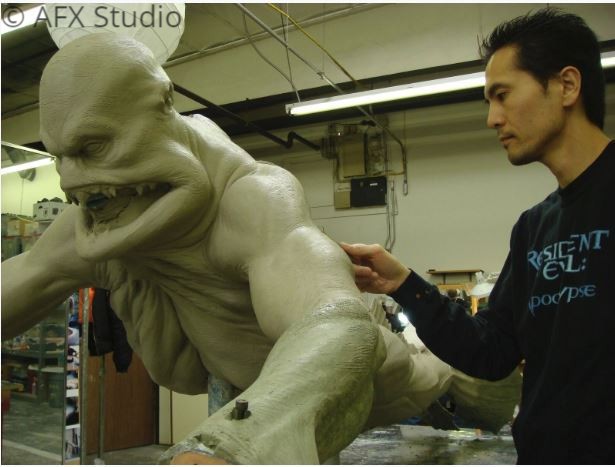
HK: CABIN IN THE WOODS. Basically, we were making every creature in the film. I was in charge of [the] ‘Mer-man’. It’s a pretty important character and I was happy to be working on that. [There were multiple designs]. The director chose which one he liked and after that I didn’t have any directions anything I made was just fine… just keep going. He didn’t ask for approval. I just kept moving on. I had a creative freedom which was really REALLY nice but on the other hand, it was one of the hardest jobs because it was so much to do and so much responsibility. Not just the sculpting, I was responsible from beginning to the end. So, I was on set, [at] the test fittings, making the molds, and casting [the suit], paint [the suit]. I did everything.
You’ve seen the movie of course. There’s a blow-hole on the back [of the Mer-man suit]. It was to shoot blood but like a whale. I thought that was a great idea. Our [group] though was makeup effects and shooting the blood was special effects, which is a different department, So, we didn’t have any control [over] how to shoot the blood. The special effects guy put the tube inside of the suit to prepare for the shoot. There were, I don’t know, twenty gallons of blood [laughs]. The special effects guy shoots the blood and it’s like a fountain [laughs] It looked like a joke! [laughs] It’s shooting out for like twenty seconds and it just kept going [creating] this huge puddle of blood [that] was all over. At the last minute, there is air and a little bit of liquid that shoots out, creating a misting. That was what the director decided to use because misting is more like a whale.
The performer, Richard Cetrone is his name, basically, he had no legs [in the suit]. His legs were tied up. He laid down. He had the back fin [on the suit] so he couldn’t sit. So, the only choice he had was to lay down or on his side, for like six hours. Poor guy. [laughs]. So each take, he crawls forwards and there was carpet… the material of the suit is like [a] sponge… foam latex, it’s like a sponge. Every time he crawled on the carpet, the suit decays… it comes apart. There was also the hair on the Mer-man, the director liked the hair because nobody has seen a fish guy with hair. So, the Mer-man had hair but every time he crawls the hair was pulling out! [laughs]. The director would yell cut and it would take six people just to pull him back… and there were like ten takes. [laughs] When he got from the suit, he couldn’t stand up for a while because he got so numb. What a great performer! Not a single complaint and he did it so well.
_large.jpg)
W: It’s such a memorable part of the movie. It gets such a big reaction.
HK: Thank you. I am very proud of it.
W: What were some of the other creatures you designed for the film?
HK: There was the alien. It was cut from the movie. It was one of the coolest characters but he was replaced by a digital ghost. There was a puppet we created to hang from the ceiling in the glass elevator scene. [Where] the first creatures appeared. There was suppose to be [the alien] creature I created… but the creature was supposed to be hanging from the ceiling. On the set though, there was no ceiling. It was open so no place to hang, we had puppeteers to move it. My guess is that the movement didn’t look natural since we had no way to hang it [up]. The creature was really cool. [laughs] [Author’s Note: I asked Hiroshi if he had any images of the unused alien puppet to share with us and he provided these images]
_large.jpg)
W: In your directorial debut, GEHENNA: WHERE DEATH LIVES, you work with Doug Jones and you have both worked with Guillermo del Toro, in the past. Tell me a little about working with Guillermo on a project like PACIFIC RIM.
HK: Before the movie was even greenlit, Guillermo had to do a presentation for the studio. So, he had to do a bunch of artwork, a video, and maquettes… a diorama. I sculpted the robot for the [Warner Bros presentation]. I sculpted the first Jaeger ever! [laughs]
W: Oh really!
HK: Yep. They liked it. I was working for a studio called SPECTRAL MOTION. So [Guillermo] hired me to sculpt the robot and another artist to sculpt the kaiju, the monster. So, we created the diorama where the robot and monster are fighting. Soon after they decided to make his movie. It was greenlighted and since I sculpted that once the movie got started, I got to choose which robot I got to sculpt. Of course, I chose “Gypsy Danger”, the main robot. Guillermo likes the physical effects. He use to do that himself. It started from one drawing… one concept design for the robot. It was very limited. It was just one angle. I was just guessing [the other angles in] the design. At the same time, the digital artists [were working on it too]. It makes me wonder, “Why am I doing this if they are going to do it digitally?” …
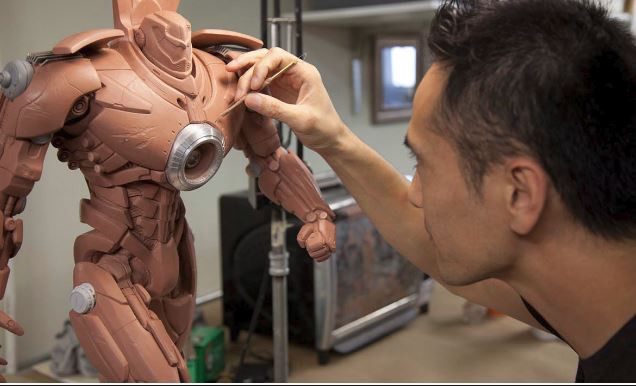
They ended up scanning the sculpture, but I doubt how much they used it. My guess is Guillermo just wanted to have that [sculpture]. [laughs] So, I sculpted that and the Japanese robot, Tacit Ronin, but after a few days they cut that character for budget reasons. So, I couldn’t save Japan, myself [laughs]
W: That’s a shame, I’m sure it was a beautiful design. [Author’s Note: I located this image of the unfinished sculpture of ‘Tacit Ronin”]
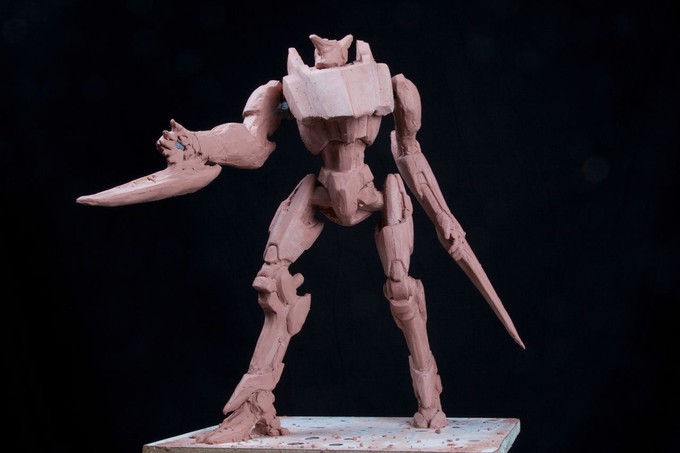
Moving on to your new film, GEHENNA: WHERE DEATH LIVES, what are some of the challenges of making a low to mid-budget horror film?
HK: Yes. It’s very low budget. One of the biggest issues before shooting was the location. Looking at Los Angeles, we found out how much people we charging to use a location. So, it was a really, REALLY big issue to find a good priced location. That’s a big challenge, [to] find a good place within the budget. Also, the other big issue is the makeup effects. Normally it’s like a horror movie or a sci-fi show… it cost a lot because of the effects but since I do this job myself for a long time… twenty-five years… I can work on it myself. [That] saves money but It’s more work [for me], of course. Besides directing I made so many things for this film. Simultaneously, doing producer work, storyboarding and… [laughs]. You know It is many things! It’s a big challenge.
W: Smaller films often need recognizable names to draw people in and you have two great ones in this project with Lance Henriksen and Doug Jones with GEHENNA: WHERE DEATH LIVES?
HK: Well, Doug Jones is very famous among our industry. So, [I’ve known} him since 1996… since a show called CRUSADE [created by J. Michael Straczynski]. It’s a TV series. It’s not too popular in the U.S. It was kind of popular in Europe. I met him [for the] first time [there]. There are so many projects we worked [on] together; BUFFY THE VAMPIRE SLAYER, X-FILES, HELLBOY, and DOOM. Many shows… he knows me. I know him. [laughs] Pretty much everyone in the [special makeup effects] industry knows him. I planned this film and then I tried to see if he could help this project out. I just contacted him and he very nicely accepted. Luckily, he was not too busy at that time.
For Lance, …it was kind of unique. He was invited [to] a convention for fans in Japan. So, I knew the convention producer …I had a good relationship with him. He was very supportive of my film. One day, he called me up from Japan and he told me, “Hey, I’m at the convention and I’ve got Lance Henriksen here and I told him about your project and he said he could be in your film”! I said, “Really!” [laughs] He said, “Here’s Lance.”, and then Lance was speaking to me! [laughs]
W: He’s got that unmistakable voice.
HK: Right! So there was no bullshitting. [Lance] meant it.
W: I’ve actually met him once before. He’s a very nice man.
HK: Oh yes… both of them, Lance and Doug Jones.
W: Just a couple more questions before I let you go. What’s the most difficult thing about moving from a very specialized role like special effects make up to a more generalized role like directing?
HK: The hardest thing is really everything, backgrounds, costumes, makeup, props .. and THEN directing. I have to decide everything. [laughs] It used to be just 30-40 seconds of a movie. Now it’s the entire movie… choosing music, the sound… everything. That’s a huge challenge and at the same time, I have to direct everybody. That’s another thing, dealing with so many people. You could be like a James Cameron and scream and make demands of everybody. [laughs] I can’t do that. I have to cheer up people. People are being in the movie [just to help] or working for cheap. I have to be nice. I can do that normally but when shooting starts, it’s hard. [laughs]
W: I’ve got one last question and you don’t have to answer but I know you are working on CAPTAIN MARVEL right now. Can you tell me anything about what you are doing on the film?
HK: There are aliens. There are aliens in CAPTAIN MARVEL. I’m also working on [the new] AVATAR.
W: You are working on AVATAR 2?
HK: [laughs] This one I can’t say [too much on].
W: Are you designing aliens for CAPTAIN MARVEL?
HK: Just sculpting. They are designed already. [I have been working on the film] since the end of December… on and off for three or four months. A lot of effects, like GUARDIANS OF GALAXY. It’s a huge makeup show. So many aliens.. in makeup, not digital… physical makeup. Another amazing thing is we are shooting in Los Angeles, which is rare… a movie this size… shooting in L.A. It’s a miracle.
W: Well, Hiroshi thank you for time. It was a true pleasure, sir.
HK: Thank you!
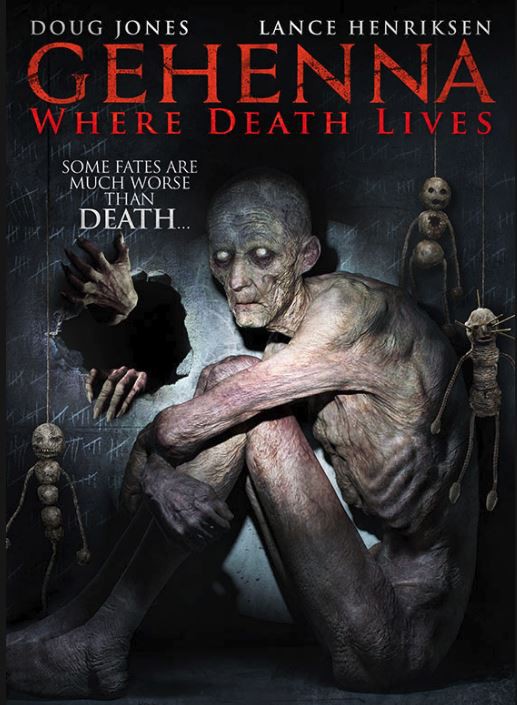
GEHENNA: WHERE DEATH LIVES has a limited theatrical release and drops on to all VOD platforms starting on May 4th
-Wheels
